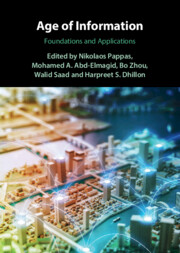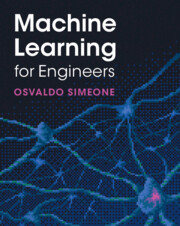Refine listing
Actions for selected content:
9096 results in Communications, Signal Processing and Information Theory
7 - Sampling and Scheduling for Minimizing Age of Information of Multiple Sources
-
-
- Book:
- Age of Information
- Published online:
- 02 February 2023
- Print publication:
- 09 February 2023, pp 166-198
-
- Chapter
- Export citation
12 - Age of Information in Practice
-
-
- Book:
- Age of Information
- Published online:
- 02 February 2023
- Print publication:
- 09 February 2023, pp 297-326
-
- Chapter
- Export citation
10 - Age of Information and Remote Estimation
-
-
- Book:
- Age of Information
- Published online:
- 02 February 2023
- Print publication:
- 09 February 2023, pp 259-282
-
- Chapter
- Export citation
6 - Age of Information in Source Coding
-
-
- Book:
- Age of Information
- Published online:
- 02 February 2023
- Print publication:
- 09 February 2023, pp 140-165
-
- Chapter
- Export citation
9 - Age-Driven Transmission Scheduling in Wireless Networks
-
-
- Book:
- Age of Information
- Published online:
- 02 February 2023
- Print publication:
- 09 February 2023, pp 230-258
-
- Chapter
- Export citation
Contents
-
- Book:
- Age of Information
- Published online:
- 02 February 2023
- Print publication:
- 09 February 2023, pp v-vi
-
- Chapter
- Export citation

Age of Information
- Foundations and Applications
-
- Published online:
- 02 February 2023
- Print publication:
- 09 February 2023

Machine Learning for Engineers
-
- Published online:
- 25 January 2023
- Print publication:
- 03 November 2022
-
- Textbook
- Export citation
39 - Decoding Hidden Markov Models
-
- Book:
- Inference and Learning from Data
- Published online:
- 17 March 2023
- Print publication:
- 22 December 2022, pp 1563-1608
-
- Chapter
- Export citation
Notation
-
- Book:
- Inference and Learning from Data
- Published online:
- 17 March 2023
- Print publication:
- 22 December 2022, pp xlv-lii
-
- Chapter
- Export citation
48 - Value Function Approximation
-
- Book:
- Inference and Learning from Data
- Published online:
- 17 March 2023
- Print publication:
- 22 December 2022, pp 2008-2046
-
- Chapter
- Export citation
29 - Linear Regression
-
- Book:
- Inference and Learning from Data
- Published online:
- 17 March 2023
- Print publication:
- 22 December 2022, pp 1121-1153
-
- Chapter
- Export citation
37 - Latent Dirichlet Allocation
-
- Book:
- Inference and Learning from Data
- Published online:
- 17 March 2023
- Print publication:
- 22 December 2022, pp 1472-1516
-
- Chapter
- Export citation
Notation
-
- Book:
- Inference and Learning from Data
- Published online:
- 17 February 2023
- Print publication:
- 22 December 2022, pp xlv-lii
-
- Chapter
- Export citation
4 - Optimization Landscape of Neural Networks
-
-
- Book:
- Mathematical Aspects of Deep Learning
- Published online:
- 29 November 2022
- Print publication:
- 22 December 2022, pp 200-228
-
- Chapter
- Export citation
5 - Explaining the Decisions of Convolutional and Recurrent Neural Networks
-
-
- Book:
- Mathematical Aspects of Deep Learning
- Published online:
- 29 November 2022
- Print publication:
- 22 December 2022, pp 229-266
-
- Chapter
- Export citation
Subject Index
-
- Book:
- Inference and Learning from Data
- Published online:
- 17 February 2023
- Print publication:
- 22 December 2022, pp 1033-1052
-
- Chapter
- Export citation
31 - Maximum Likelihood
-
- Book:
- Inference and Learning from Data
- Published online:
- 17 March 2023
- Print publication:
- 22 December 2022, pp 1211-1275
-
- Chapter
- Export citation
Frontmatter
-
- Book:
- Inference and Learning from Data
- Published online:
- 17 March 2023
- Print publication:
- 22 December 2022, pp i-iv
-
- Chapter
- Export citation
47 - Q-Learning
-
-
- Book:
- Inference and Learning from Data
- Published online:
- 17 March 2023
- Print publication:
- 22 December 2022, pp 1971-2007
-
- Chapter
- Export citation
